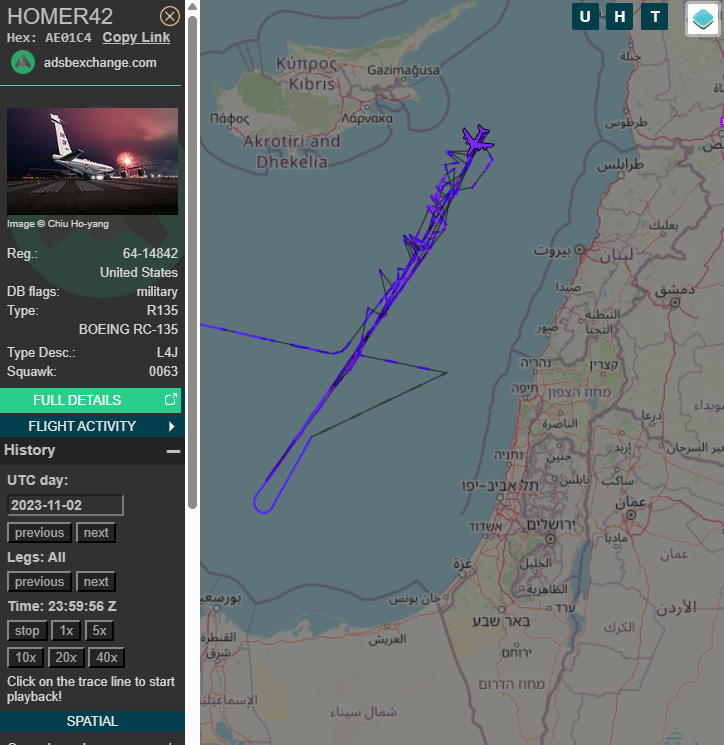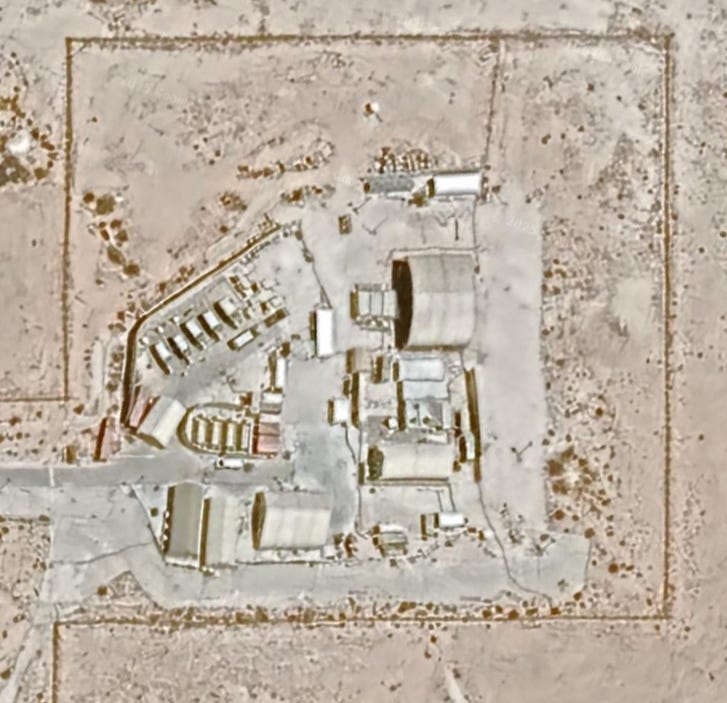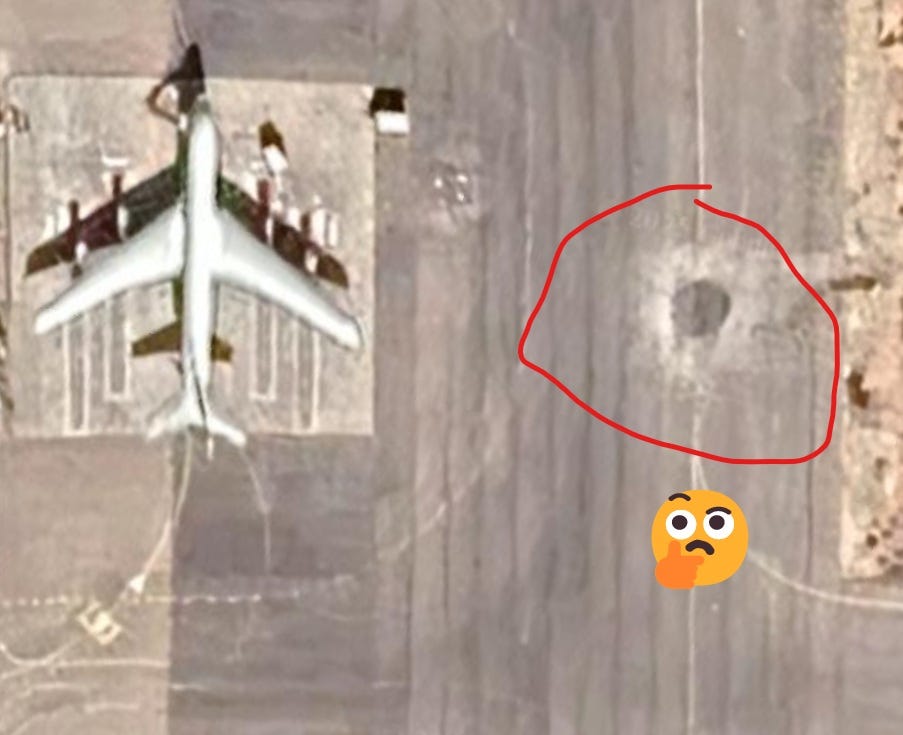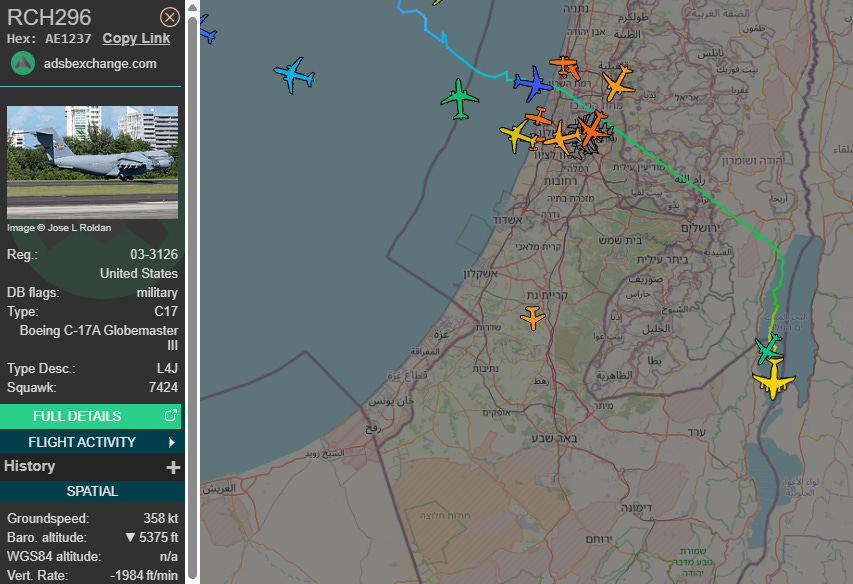Everybody knows the United States provides a lot of money and other assistance to the Israeli military. That much is common knowledge. But what does that actually mean in practice? And how essential is that aid to the operations of the Israeli military?
I’ve seen a lot of commentators online - usually nice liberals - who say something to the effect of: “I don’t support what Netanyahu is doing, but Israel doesn’t need our bombs and assistance to do all this, they have their own military industry and can just do it on their own. We need to supply them in order to have leverage,” or, “If the U.S. stops supplying them, Israel will just go to China or Russia, and then the U.S. loses leverage and Israel will now be friends with an evil country.”
I will examine those claims, but I want to start out with just laying out some facts about direct U.S. military involvement over the course of the war that has engulfed the region since October 7, 2023. Because the U.S. is not a passive observer, nor is it merely supplying arms and money - no, the United States is a direct combatant in the wars in Gaza, Lebanon, and elsewhere.
Outside the provision of arms and money, the U.S. military has been directly involved in gathering intelligence and providing it to Israel. This intelligence gathering has not been passive - i.e. through existing collection methods, such as trawling the internet at the NSA or satellite photos that would have been taken anyway.
For example, the U.S. military has been flying drones and other surveillance aircraft over Gaza and Lebanon since day one of the conflict. Case in point, this U.S. Air Force RC-135 Rivet Joint surveillance aircraft flew in circles off the coasts of Gaza and Lebanon for hours on November 2, 2023.
Here it is again on November 6, 2023.
And November 11, 2023.
And November 17, 2023.
You get the idea. An RC-135 Rivet Joint is an electronic surveillance aircraft - a highly specialized bit of kit that very few militaries have the funding and personnel available to expend resources on. The RC-135, basically, is designed to intercept and interpret all sorts of electronic signals, and turn that intelligence into immediately actionable data for combat troops. In other words, intercept any sort of electronic signal and turn it into targeting data. The U.S has several dozen of the things. Israel, notably, does not have any RC-135s and is limited in its availability and effectiveness of similar surveillance aircraft.
This one aircraft, shown above, callsign HOMER42, was certainly not the only one involved, and these not the only dates it was flying in the area. A wide variety of U.S. military aircraft have been carrying out similar reconnaissance missions throughout the duration of the conflict, and providing intelligence to Israel to use for military purposes.
This NYT article claims that “Defense Department officials have insisted that they are not directly supporting Israeli military operations on the ground in Gaza . . . But the search for top Hamas leaders was different, officials said.”
I’m not entirely certain how one squares the circle that providing intelligence to find and eliminate “top Hamas leaders” is somehow not “directly supporting Israeli military operations on the ground” but then again, I’m not a Pentagon spokesperson.
According to a variety of both U.S. and Israeli officials, American intelligence was used in the June 8 rescue of four Israelis held hostage since October 7. This incident is also widely referred to as the Nuseirat Massacre, in which hundreds of Palestinian civilians were killed in a very short time period. This was also the incident in which the infamous U.S. “humanitarian pier” area was used by the Israeli military as a helicopter staging area for the hostage extraction.
To quote the NYT:
”The Pentagon and the C.I.A. have been providing information collected from drone flights over Gaza, communications intercepts and other sources about the potential location of hostages. While Israel has its own intelligence, the United States and Britain have been able to provide intelligence from the air and cyberspace that Israel cannot collect on its own, the Israeli official said.”
During the hostage rescue, Israeli forces disguised themselves in civilian vehicles marked to look like humanitarian aid vehicles. This is a war crime, by the way.
So while U.S. intelligence is somehow not helping with Israeli ground operations, it is helping with some of the most infamous war crimes of the conflict.
Moving on.
The U.S military has also been bolstering the defense of Israel against Iran for a while, which has obviously stepped up due to recent events. Even before October 7, the U.S. was preparing to deploy missile defense to Israel against the threat of Iranian ballistic missiles. To that end, the U.S. built a secretive facility in the Negev desert, dubbed Site 512, to be the base for a missile defense radar system - the AN/TPY-2.
Here’s the site on Google Earth. Doesn’t look like much, and it is mostly a facility to house the troops necessary to operate the radar system. Here’s a close-up of the radar:
The large soft-shell tent towards the center covers the radar. This facility is pointed vaguely northeast, towards the likely trajectory of incoming Iranian ballistic missiles. It cannot be easily turned around and pointed towards Gaza or elsewhere. Israel has its own missile defense radars - such as the Green Pine radar (an example of which is shown below). The Green Pine, however, has a significantly shorter detection range than the AN/TPY-2, which means that the crucial early detection of incoming missiles as far away as Iran relies on the American system.
Israel has a handful of such radars located throughout Israel, primarily linked to the Israeli(ish) Arrow and David’s Sling missile defense systems. These systems performed admirably during the first Iranian ballistic missile attack in April of 2024, but were certainly provided significant assistance in detection by the American systems, such as the AN/TPY-2 radar located at Site 512, operated by U.S. military personnel.
Speaking of the Iranian missile attacks, it’s reasonably well known (but bears repeating) that the U.S. military very directly took part in shooting down incoming missiles and drones, both in the April and October attacks. Of particular note is the U.S. involvement in the April attack, during which Iran launched several hundred drones and cruise missiles. Such weapons travel relatively slowly and at low altitude, requiring several hours to go from western Iran to their targets in Israel. Over the course of the night, U.S. fighter aircraft (joined by smaller numbers of Israeli, French, British, and Jordanian aircraft) shot down more or less all of these slow-moving drones and missiles over Iraq and Jordan.
This freed up Israeli defense resources to focus on the incoming ballistic missiles, and prevented Israeli short range air defense systems like the famous Iron Dome from having to expend hundreds of interceptor missiles to shoot down the drones and cruise missiles.
Notably, after the October 1st Iranian missile attack achieved considerably more success (to be discussed in great detail in a later article), the U.S. announced that it would move one of its THAAD missile defense system to Israel to help defend against future ballistic missile attacks.
The U.S. only has a handful of THAAD systems. Each system consists of six launch vehicles, each carrying eight missiles, and a radar. Notably, the THAAD uses the AN/TPY-2 radar system discussed above, meaning the Site 512 facility was designed from the start to host the THAAD.
The deployment of the THAAD to Israel (and the recent rumored deployment of a second THAAD battery) is interesting to analyze in their predicted ability to defend against a possible third Iranian attack. But that’s a discussion for another day. Bare minimum, it means U.S. military personnel are actively participating in the defense of Israel against threats from Iran and Yemen. Notably, the THAAD system was alleged to have intercepted ballistic missiles launched by the Ansarallah (Houthis) movement in Yemen.
Anyway, here’s the U.S. THAAD battery in Israel on December 28, 2024, visible on Google Earth.
You’ve got the six black dots on the right as the launch vehicles, and the facility on the left is the housing and support structures, as well as the AN/TPY-2 radar (shown below in close-up).
Each one of these systems costs over a billion dollars, and each missile over ten million dollars. Every dollar expended here is a dollar that Israel does not need to spend for this purpose, and thus can spend elsewhere.
Now, on to the next topic.
Let’s look at the Israeli Air Force’s biggest base - the Nevatim Air Base located a few miles from the city of Beersheva. This base is home to quite a lot of the Israeli Air Force’s aircraft, most notably its contingent of the U.S. made F-35 stealth fighter/bomber. Israel currently has roughly 40 of the jets, and they are all based at Nevatim. They live in specially-built shelters that are hardened against attack.
Here’s what those shelters look like from space.
Who can we thank for those aircraft shelters? Well, none other than the United States Army!
Similarly, the U.S. will be renovating the Nevatim base to house new Boeing KC-46 aerial refueling aircraft, to replace the old Boeing 707 aircraft Israel uses for that purpose. The work will cost approximately a billion dollars, paid for by the U.S. Department of Defense. The article and procurement notice doesn’t specify Nevatim, but that’s where the current 707s are based - seen on Google Earth below.
This image is from December 28, 2024. But wait, what’s that little circle just off to the right of the 707s, on the tarmac?
That is the impact point of an Iranian missile launched on October 1, 2024. As always, to be discussed in more detail later! Suffice it to say, the Israelis will be very grateful to have another billion dollar U.S. military project to make their bases harder to destroy.
Of course, much of the U.S. military aid to Israel has been in the form of weapon supplies. This is certainly the most impactful of all the support Israel receives, the specifics of which I will discuss in the next part of this series.
But how do most of those weapons reach Israel? Not through FedEx. Indeed, the majority of U.S. arms support to Israel are transported via U.S. Air Force C-17 Globemaster transport jets. In August of 2024, it was reported that over 500 transport flights had been carried out during the war thus far, along with over 100 sea-shipments. That is, of course, an average of about 1.5 shipments by plane or by ship per day. While I don’t know for sure about the sea-based shipments, I know that the air-based shipments were carried out primarily, as mentioned, by U.S. Air Force transport jets.
Here is one such flight just this past Sunday - the aircraft turned off its transponder as it went in to land, but it clearly landed at the now-familiar Nevatim airbase, and took off a few hours later, its cargo unloaded.
Now, I do not know whether or not Israel reimbursed the Air Force for their flight hours. When USAID uses U.S. military assets to carry out humanitarian logistics - a not uncommon event - USAID pays a set rate depending on the type of aircraft. I don’t remember the exact cost, but it’s not cheap - in the tens of thousands per hour of use. It covers fuel, maintenance, and other costs. We can be generous and assume Israel pays for these flights (I doubt it), but the bottom line is that these flights are operated by the U.S. military.
This means that, if the President (as Commander in Chief of the military), did not want to supply weapons to Israel, he could simply order the military to not take part in that supply. Israel could still contract with private firms in the U.S. to purchase weapons with either their own money or funds allocated by Congress - a process the President can’t stop - and theoretically pay private transport companies to carry the weapons from the U.S. to Israel. There is no need to have the U.S. military participate in this process, other than to prevent Israel from having to bear the financial and logistical cost of transferring the weapons.
Of course, the President could also order the State Department, which authorizes each and every sale of U.S.-made weapons to foreign countries, to simply follow existing U.S. law to prevent the approval of sales to Israel until Israel follows international law.
Let’s zoom out a little bit. It’s well known that Israel has a highly capable military. It has a large army, a large air force, and possesses highly advanced military technology across all domains. Israel has a GDP and population very roughly equivalent to Ireland, Sweden, or Singapore. Ireland has barely any military at all, for political reasons. Sweden and Singapore both have respectable militaries, but are certainly unable to compete with Israel in terms of the number of advanced fighter jets they field, or the number of modern tanks and armored vehicles they have, or possession of a robust and advanced air defense system that encompasses short range systems all the way to advanced ballistic missile defense. Only much larger countries are able to compete across all fields of military technology and simultaneously actually deploy that technology in significant amounts.
All this, despite being a country that is small both in geographical size as well as population. It punches well above its weight. A large part of this is because of direct U.S. financial assistance, which is well known. This assistance gives Israel extra cash to buy weapons from abroad and develop its own weapons domestically. Billions a year, at least $130 billion total and at least $18 billion between October 7, 2023 and October of 2024 alone.
But this number is only one part of the amount of money spent on the military defense of Israel. All the systems and work discussed above amounts to tens of billions of dollars more, both before October 7 and since. The AP article above describes at least $4.86 billion in direct U.S. military costs for operations in support of Israel in the year after October 7. The actual number is undoubtedly much higher, once all possible elements have been accounted for.
All of those costs - the U.S. Air Force transport flights, the THAAD deployment, each SM-3 missile launched from the USS Bulkeley to shoot down Iranian missiles (at a cost of up to $27 million per missile), each $30 million MQ-9 Reaper shot down over Yemen, every B-2 Spirit bomber mission over Yemen (at a cost per hour of at least $163,000 and a total B-2 program cost of at least $70 billion 1990 dollars) every RC-135 Rivet Joint reconnaissance flight off the coast of Gaza - all of these represent costs of Israeli military operations paid for entirely by the United States.
Each dollar spent by the U.S. military defending Israel is a dollar that Israel does not have to spend. Each THAAD missile the U.S launches represents $10 million worth of missile defense that Israel can spend on buying more bombs to drop on Gaza, or paying to recruit more soldiers, or repairing more tanks and armored vehicles, or developing new surveillance software to track the movement of Palestinians in the West Bank. This has a huge effect, where direct U.S. military support to Israel allows U.S. financial support to have an outsized impact, which in turn allows the Israeli military to maintain a far larger and advanced military than they can actually afford.
Turning off direct U.S. military support would have a cascading effect, where suddenly those costs are shouldered directly by Israel - they cannot afford to do this. They do not have the money to buy dozens of RC-135 Rivet Joints to fly off the coast of Gaza, or develop their own B-2 strategic stealth bomber to hit targets in Yemen, or transport 500 loads of weapons in less than a year - and also maintain a fleet of hundreds of tanks, pay hundreds of thousands of soldiers, drop tens of thousands of tons worth of bombs, buy and maintain over 300 modern combat aircraft, and so on and so forth. They would start having to make choices about what to prioritize, which would have an immediate impact in reducing their ability to carry out their existing expansionist and escalatory actions against nearly all of their neighbors.
This theme will continue when we discuss their domestic military production and their ability to pivot to a different foreign benefactor in subsequent articles.
The basic theme is this: Israel is just as constrained by financial and physical limitations as everyone else, but U.S. support has allowed them to maintain a facade of somehow being free of those limitations. Remove U.S. support, and suddenly Israel doesn’t seem so special.

















